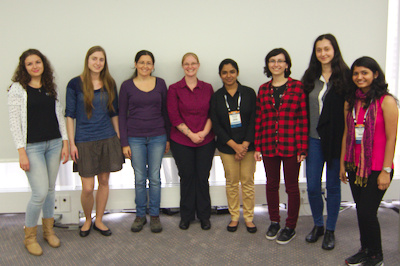I ran into some issues with installing Debian on my new Hawell ASUS zenbook laptop. I’m documenting it on my blog to try and ease anyone else’s struggles.
I used the Debian CD image instead of the netinstall. I accidentally installed Debian stable, but later added apt sources to use Debian testing. I used the 20140712 Wheezy amd64 install ISO on a USB 3.0 flash drive. The drive was plugged into the right side, but I doubt that makes a difference.
Step 1: Reconfigure the BIOS boot options.
Plug in the USB drive, and boot the laptop while pressing F2 to go into the BIOS. Go into the boot menu, secure boot menu, and disable secure boot. Go back to the boot menu and enable CSM. Change the boot order so that the USB UEFI boot option is first (before the Windows boot option). Save, unplug the USB drive, exit BIOS, and boot into Windows.
Step 2: Repartition drives in Windows.
Hit Windows key, type ‘disk’ and click the partitioner. I had the laptop version with two 256GB drives with software raid, which showed up as a 256GB drive D:/ and a 200GB drive C:/. I deleted drive D:/, and shrunk drive C:/ as much as the partitioner would allow (which still left 60GB free for Windows to use for my Steam games that don’t have Linux support yet).
Step 3: Go through some of the Debian installer process.
Start the Debian installer. Ignore that it can’t find our network device, pick a host name and add root and normal users. Choose ‘Manual’ when it comes to partitioning disks. You’ll see the software raid partition looks like this:
Step 4: Fix the EFI partition. Select the fat32 EFI system partition, and change ‘Use as’ to ‘EFI boot partition’.
Step 5: Add a new Linux partition.
Choose ‘Automatically partition the free space’ and choose ‘All files in one partition’. Once the partitions are created, select the ext4 root partition (‘/’) and (optionally) change the mount options to include relatime. This means that file timestamps aren’t updated automatically, which means less disk writes to the SSDs, thus increasing the lifetime of the disks. If you like, set a label for the root partition so you can see it in Windows later. After you’re done, the partition disks screen should look like this, and you can hit ‘Finish partitioning and write changes to disk’:
Step 6: Go further in the Debian install process.
Don’t use a network mirror. Pick whether you want to send installed package information to Debian or not. Select Debian desktop and system utilities and continue.
Step 7: Fix grub install failure.
Jamey Sharp figured this out, thanks for his help! It seems that the standard grub installer was confused by the “Intel Matrix Storage Manager” or IMSM, that’s firmware for booting to RAID setups. Basically, the BIOS knew about the RAID setup, Linux (mdadm and the kernel) knew about IMSM, but grub didn’t. Grub didn’t know the BIOS used IMSM and could boot from the disk, so grub didn’t think the hard drive was bootable. Silly grub!
Go to a shell by pressing CTRL+ALT+F2. Type this command:
df /target
Look at the output of that command. It will list the file system mount that corresponds to /target (the mount point of the root file system where Debian installs to). It should look something like /dev/md126p6. The ‘p6’ is one particular partition on the RAID array, but we want grub to use the whole disk, so we strip off the partition designation for the next couple of commands. Type this command:
cat > /target/boot/grub/device.map
and then type:
(hd0) /dev/md126
and hit CTRL+d to stop writing to the file. Then go back to the installer (in the text installer, that’s ATL+F1, but it’s ALT+F5 in the graphical installer). Hit ‘continue’ and ‘continue’ again to go back to the Debian installer main menu. Again, hit enter on the ‘Install grub bootloader on the hard disk’. The installation should complete successfully.
Step 8: Add grub UEFI boot option.
Unplug the USB key, and hit F2 to go back into the BIOS. The Debian installer didn’t create a UEFI boot option for the grub installation, so we have to make one manually. Go into the boot menu, and hit ‘Add New Boot Option’ and then ‘Add boot option’. Pick a name for it (‘GRUB’). Under ‘Path for boot option’, there should only be one choice of filesystem, which starts with PCI. Under ‘Select a file to boot’ choose EFI and then debian and finally grubx64.efi. Choose ‘Create’ and you’re done adding the boot option. Hit ‘escape’ to get back to the boot menu. You’ll need to change the boot option priorities to make grub the first boot option (which means you’ll need to go into the BIOS and change it back should you want to boot into Windows). Save and exit the BIOS.
Step 9: Update your packages and install Intel wireless firmware.
Debian stable (which is running a 3.2 kernel) will boot into GNOME 3 compatitbility mode because it doesn’t have kernel or mesa support ffor the Haswell Intel graphics. The kernel also doesn’t recognize the wireless PCI device. You’ll have to use the USB network adapter and plug into an ethernet cable.
Add the Debian stable sources by editing /etc/apt/sources.list so that it says:
deb http://security.debian.org/ jessie/updates main contrib non-free
deb http://ftp.us.debian.org/debian/ jessie main contrib non-free
You may want to use a different local mirror closer to you.
Run `aptitude` as root, and mark all packages that are upgradable. Mark the firmware-iwlwifi package for installation. And install all your new packages from Debian testing!
After a reboot, both wifi and graphics should be working correctly.

